This is an old revision of this page, as edited by Lunkwill (talk | contribs) at 19:47, 1 December 2006 (→See also: rv linkspam). The present address (URL) is a permanent link to this revision, which may differ significantly from the current revision.
Revision as of 19:47, 1 December 2006 by Lunkwill (talk | contribs) (→See also: rv linkspam)(diff) ← Previous revision | Latest revision (diff) | Newer revision → (diff)


Sandblasting or bead blasting is a generic term for the process of smoothing, shaping and cleaning a hard surface by forcing solid particles across that surface at high speeds; the effect is similar to that of using sandpaper, but provides a more even finish with no problems at corners or crannies. Sandblasting can occur naturally, usually as a result of the particle blown by the wind causing eolian erosion, or artificially, using compressed air. An artificial sandblasting process was patented by Benjamin Chew Tilghman on October 18, 1870.
Historically, the material used for artificial sandblasting was sand that had been sieved to a uniform size. The silica dust produced in the sandblasting process caused silicosis after sustained inhalation of dust. Sandblasting may now only be performed in a controlled environment using ventilation, protective clothing and breathing air supply (as it is shown in the top image).
Other materials for sandblasting have been developed to be used instead of sand; for example, steel grit, steel shots, copper slag, glass beads (bead blasting), metal pellets, dry ice, garnet, powdered abrasives of various grades, powdered slag, and even ground coconut shells or corncobs have been used for specific applications and produce distinct surface finishes.
Notes
- While bead blasting is technically a different process, many industrial employees use the two interchangeably